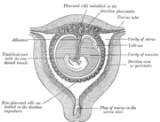
Amniotic sac
Overview
The amniotic sac is the sac in which the fetus
develops in amniotes. It is a tough but thin transparent pair of membranes, which hold a developing embryo (and later fetus) until shortly before birth. The inner membrane, the amnion, contains the amniotic fluid and the fetus. The outer membrane, the Chorion
, contains the amnion and is part of the placenta
. Its wall is the amnion
, the inner of the two fetal membranes
. It encloses the amniotic cavity
and the embryo
.
Fetus
A fetus is a developing mammal or other viviparous vertebrate after the embryonic stage and before birth.In humans, the fetal stage of prenatal development starts at the beginning of the 11th week in gestational age, which is the 9th week after fertilization.-Etymology and spelling variations:The...
develops in amniotes. It is a tough but thin transparent pair of membranes, which hold a developing embryo (and later fetus) until shortly before birth. The inner membrane, the amnion, contains the amniotic fluid and the fetus. The outer membrane, the Chorion
Chorion
The chorion is one of the membranes that exist during pregnancy between the developing fetus and mother. It is formed by extraembryonic mesoderm and the two layers of trophoblast and surrounds the embryo and other membranes...
, contains the amnion and is part of the placenta
Placenta
The placenta is an organ that connects the developing fetus to the uterine wall to allow nutrient uptake, waste elimination, and gas exchange via the mother's blood supply. "True" placentas are a defining characteristic of eutherian or "placental" mammals, but are also found in some snakes and...
. Its wall is the amnion
Amnion
The amnion is a membrane building the amniotic sac that surrounds and protects an embryo. It is developed in reptiles, birds, and mammals, which are hence called “Amniota”; but not in amphibians and fish , which are consequently termed “Anamniota”. The primary role of this is the protection of the...
, the inner of the two fetal membranes
Fetal membranes
The fetal membranes, or chorioamniotic membranes, are the amnion and chorion which surround and protect a developing fetus....
. It encloses the amniotic cavity
Amniotic cavity
The amniotic cavity is the closed sac between the embryo and the amnion, containing the amniotic fluid. The amniotic cavity is formed by the fusion of the parts of the amniotic fold, which first makes its appearance at the cephalic extremity, and subsequently at the caudal end and sides of the embryo...
and the embryo
Embryo
An embryo is a multicellular diploid eukaryote in its earliest stage of development, from the time of first cell division until birth, hatching, or germination...
.
Discussions

